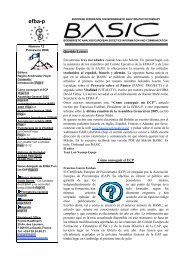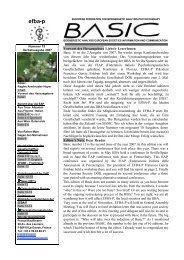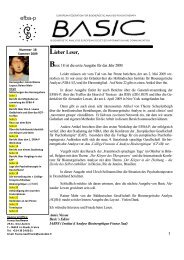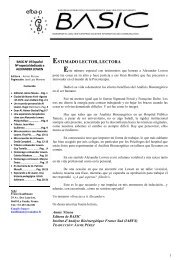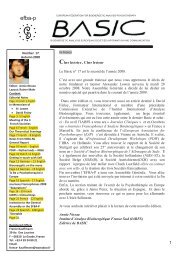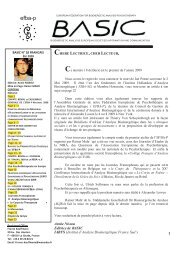December 2004 - European Federation for Bioenergetic Analysis ...
December 2004 - European Federation for Bioenergetic Analysis ...
December 2004 - European Federation for Bioenergetic Analysis ...
Create successful ePaper yourself
Turn your PDF publications into a flip-book with our unique Google optimized e-Paper software.
Every candidate must provide evidence of a minimum of 140 hours individual therapy in<br />
<strong>Bioenergetic</strong> <strong>Analysis</strong>, at least part of which should take place accompanying the training.<br />
From the second year of training practising therapeutic interventions becomes crucially<br />
important. At the beginning of this stage the candidate gets support from a supervisor during<br />
at least 50 sessions, part of which the supervisor may actually attend.<br />
As soon as the candidate has met all the training requirements and two supervisors have<br />
given their consent in terms of positive reports, the responsible training institute in cooperation<br />
with the international trainers may award the certification.<br />
It is particularly in diagnosis at the beginning of the psychotherapeutic work that the<br />
bioenergetic character structures play an important part.<br />
The <strong>Bioenergetic</strong> <strong>Analysis</strong> has developed a character-analytical model concerning the<br />
different psychic and somatic experiences in the early human life. (Lowen 1979, Lowen 1980,<br />
Lowen 1981, Bäurle 1988, Dietrich <strong>2004</strong>, Koemeda-Lutz 2002 C). This clearly shows, that<br />
specific life experiences, made in certain developing phases characterise the personality in a<br />
very specific way. They impress his/her behaviour, his/her relation to people, to the world,<br />
her/his expectations, her/his spiritual physical and emotional orientation, her/his somatic<br />
stance and expression. All injuries during certain developing phases constitute special<br />
personality aspects and can obstruct a satisfied and fulfilled life so definitely, that therapeutic<br />
help could be useful or is even necessary. The different character structures can thereby give<br />
valuable hints <strong>for</strong> the diagnosis and can indicate where the person is hindered in its potential<br />
and in which developing phase the injury or trauma has taken place (Heinrich 1997). But a socalled<br />
character structure always describes the person’s personality, not only its pathology<br />
(Schwieger 1998).<br />
Besides the traumatic experience and the thereby following restrictions of the life’s<br />
quality, the <strong>Bioenergetic</strong> <strong>Analysis</strong> also takes in consideration the specific skills and the<br />
characteristic identity. Because the direct expression of impulses was not possible, the body<br />
needed help concerning holding, protection, affirmation were not given the afflicted<br />
individual has provided itself with alternatives and expedients, in order to survive and develop<br />
(Schwieger 1998).<br />
The bioenergetic character structure model has described the schizoid, oral, masochistic,<br />
psychopathic (narcissistic) and rigid structure (Lowen 1979, 1980, 1981, Koemeda-Lutz 2002<br />
B) and meanwhile the borderline structure as well.<br />
A client's character structure can be defined on the one hand by exploring his history of<br />
development, the typical patterns of behaviour and those disorders he adopted to cope with<br />
6



